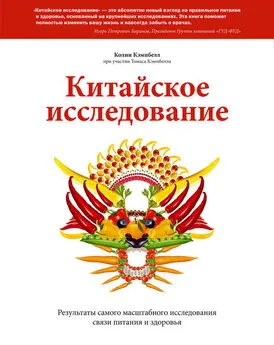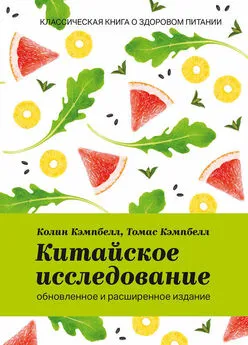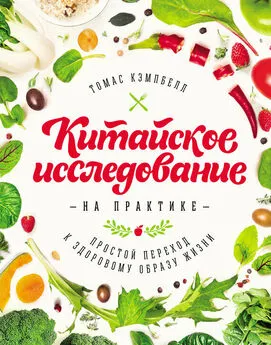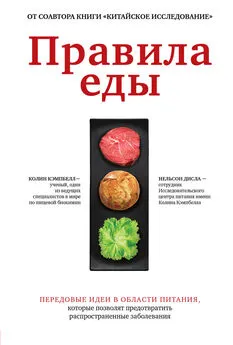Колин Кэмпбелл - Китайское исследование: обновленное и расширенное издание. Классическая книга о здоровом питании [litres]
- Название:Китайское исследование: обновленное и расширенное издание. Классическая книга о здоровом питании [litres]
- Автор:
- Жанр:
- Издательство:Литагент МИФ без БК
- Год:2018
- Город:Москва
- ISBN:978-5-00100-976-4
- Рейтинг:
- Избранное:Добавить в избранное
-
Отзывы:
-
Ваша оценка:
Колин Кэмпбелл - Китайское исследование: обновленное и расширенное издание. Классическая книга о здоровом питании [litres] краткое содержание
На русском языке публикуется впервые.
Китайское исследование: обновленное и расширенное издание. Классическая книга о здоровом питании [litres] - читать онлайн бесплатно ознакомительный отрывок
Интервал:
Закладка:
603
Scott R. J., and Sobol H. H. “Prognostic implications of cancer susceptibility genes: Any news?” Recent Results in Cancer Research 151 (1999): 71–84.
604
Burt R. W. “Colon cancer screening.” Gastroenterology 119 (2000): 837–853.
605
Burt R. W. “Colon cancer screening.” Gastroenterology 119 (2000): 837–853.
606
Lee M. L., Wang R.-T., Hsing A. W., et al. “Case-control study of diet and prostate cancer in China.” Cancer Causes and Control 9 (1998): 545–552.
607
Villers A., Soulie M., Haillot O., et al. “Prostate cancer screening (III): risk factors, natural history, course without treatment.” Progr. Urol. 7 (1997): 655–661.
608
Stanford J. L. “Prostate cancer trends 1973–1995.” Bethesda, MD: SEER Program, National Cancer Institute, 1998.
609
Chan J. M., and Giovannucci E. L. “Dairy products, calcium, and vitamin D and risk of prostate cancer.” Epidemiol. Revs. 23 (2001): 87–92.
610
Giovannucci E. “Dietary influences of 1,25 (OH)2 vitamin D in relation to prostate cancer: a hypothesis.” Cancer Causes and Control 9 (1998): 567–582.
611
Chan J. M., Stampfer M. J., Ma J., et al. “Insulin-like growth factor-I (IGF-I) and IGF binding protein 3 as predictors of advanced-stage prostate cancer.” J. Natl. Cancer Inst. 94 (2002): 1099–1109.
612
Doi S. Q., Rasaiah S., Tack I., et al. “Low-protein diet suppresses serum insulin-like growth factor 1 and decelerates the progression of growth hormone-induced glomerulosclerosis.” Am. J. Nephrol. 21 (2001): 331–339.
613
Heaney R. P., McCarron D. A., Dawson-Hughes B., et al. “Dietary changes favorably affect bond remodeling in older adults.” J. Am. Diet. Assoc. 99 (1999): 1228–1233.
614
Allen N. E., Appleby P. N., Davey G. K., et al. “Hormones and diet: low insulin-like growth factor-I but normal bioavailable androgens in vegan men.” Brit. J. Cancer 83 (2000): 95–97.
615
Chan J. M., Stampfer M. J., Ma J., et al. “Insulin-like growth factor-I (IGF-I) and IGF binding protein 3 as predictors of advanced-stage prostate cancer.” J. Natl. Cancer Inst. 94 (2002): 1099–1109.
616
Cohen P., Peehl D. M., and Rosenfeld R. G. “The IGF axis in the prostate.” Horm. Metab. res. 26 (1994): 81–84.
617
Chan J. M., Stampfer M. J., Ma J., et al. “Insulin-like growth factor-I (IGF-I) and IGF binding protein 3 as predictors of advanced-stage prostate cancer.” J. Natl. Cancer Inst. 94 (2002): 1099–1109.
618
Doi S. Q., Rasaiah S., Tack I., et al. “Low-protein diet suppresses serum insulin-like growth factor 1 and decelerates the progression of growth hormone-induced glomerulosclerosis.” Am. J. Nephrol. 21 (2001): 331–339.
619
Heaney R. P., McCarron D. A., Dawson-Hughes B., et al. “Dietary changes favorably affect bond remodeling in older adults.” J. Am. Diet. Assoc. 99 (1999): 1228–1233.
620
Allen N. E., Appleby P. N., Davey G. K., et al. “Hormones and diet: low insulin-like growth factor-I but normal bioavailable androgens in vegan men.” Brit. J. Cancer 83 (2000): 95–97.
621
Ornish D., Weidner G., Fair W. R., et al. “Intensive lifestyle changes may affect the progression of prostate cancer. J. Urol. 174 (2005): 1065–1069; discussion 1069–1070.
622
Ornish D., Weidner G., Fair W. R., et al. “Intensive lifestyle changes may affect the progression of prostate cancer. J. Urol. 174 (2005): 1065–1069; discussion 1069–1070.
623
Ornish D., Magbanua M. J., Weidner G., et al. “Changes in prostate gene expression in men undergoing an intensive nutrition and lifestyle intervention.” Proc. Natl. Acad. Sci. USA. 105 (2008): 8369–8374.
624
Frattaroli J., Weidner G., Dnistrian A. M., et al. “Clinical events in prostate cancer lifestyle trial: results from two years of follow-up.” Urol. 72 (2008): 1319–1323.
625
Yang M., Kenfield S. A., Van Blarigan E. L., et al. “Dietary patterns after prostate cancer diagnosis in relation to disease-specific and total mortality.” Cancer Prev. Res. 8 (2015): 545–551.
626
Yang M., Kenfield S. A., Van Blarigan E. L., et al. “Dairy intake after prostate cancer diagnosis in relation to disease-specific and total mortality.” Int. J. Cancer 137 (2015): 2462–2469.
627
Mackay I. R. “Tolerance and immunity.” Brit. Med. J. 321 (2000): 93–96.
628
Jacobson D. L., Gange S. J., Rose N. R., et al. “Short analytical review. Epidemiology and estimated population burden of selected autoimmune diseases in the United States.” Clin. Immunol. Immunopath. 84 (1997): 223–243.
629
Cooper G. S., Bynum M. L., Somers E. C. “Recent insights in the epidemiology of autoimmune diseases: improved prevalence estimates and understanding of clustering of diseases.” J. Autoimmun. 33 (2009): 197–207.
630
Jacobson D. L., Gange S. J., Rose N. R., et al. “Short analytical review. Epidemiology and estimated population burden of selected autoimmune diseases in the United States.” Clin. Immunol. Immunopath. 84 (1997): 223–243.
631
Jacobson D. L., Gange S. J., Rose N. R., et al. “Short analytical review. Epidemiology and estimated population burden of selected autoimmune diseases in the United States.” Clin. Immunol. Immunopath. 84 (1997): 223–243.
632
Jacobson D. L., Gange S. J., Rose N. R., et al. “Short analytical review. Epidemiology and estimated population burden of selected autoimmune diseases in the United States.” Clin. Immunol. Immunopath. 84 (1997): 223–243.
633
Aranda R., Sydora B. C., McAllister P. L., et al. “Analysis of intestinal lymphocytes in mouse colitis mediated by transfer of CD4+, CD45RBhigh T cells to SCID recipients.” J. Immunol. 158 (1997): 3464–3473.
634
Aranda R., Sydora B. C., McAllister P. L., et al. “Analysis of intestinal lymphocytes in mouse colitis mediated by transfer of CD4+, CD45RBhigh T cells to SCID recipients.” J. Immunol. 158 (1997): 3464–3473.
635
Davidson A., and Diamond B. “Autoimmune diseases.” New Engl. J. Med. 345 (2001): 340–350.
636
Folgar S., Gatto E. M., Raina G., et al. “Parkinsonism as a manifestation of multiple sclerosis.” Movement Disorders 18 (2003): 108–113.
637
Jacobson D. L., Gange S. J., Rose N. R., et al. “Short analytical review. Epidemiology and estimated population burden of selected autoimmune diseases in the United States.” Clin. Immunol. Immunopath. 84 (1997): 223–243.
638
Davidson A., and Diamond B. “Autoimmune diseases.” New Engl. J. Med. 345 (2001): 340–350.
639
Cantorna M. T. “Vitamin D and autoimmunity: is vitamin D status an environmental factor affecting autoimmune disease prevalence?” Proc. Soc. Exp. Biol. Med. 223 (2000): 230–233.
640
DeLuca H. F., and Cantorna M. T. “Vitamin D: its role and uses in immunology.” FASEB J. 15 (2001): 2579–2585.
641
Jacobson D. L., Gange S. J., Rose N. R., et al. “Short analytical review. Epidemiology and estimated population burden of selected autoimmune diseases in the United States.” Clin. Immunol. Immunopath. 84 (1997): 223–243.
642
Winer S., Astsaturov I., Cheung R.K., et al. “T cells of multiple sclerosis patients target a common environmental peptide that causes encephalitis in mice.” J. Immunol. 166 (2001): 4751–4756.
643
Davenport C. B. “Multiple sclerosis from the standpoint of geographic distribution and race.” Arch. Neurol. Psychiatry 8 (1922): 51–58.
644
Alter M., Yamoor M., and Harshe M. “Multiple sclerosis and nutrition.” Arch. Neurol. 31 (1974): 267–272.
645
Mackay I. R. “Tolerance and immunity.” Brit. Med. J. 321 (2000): 93–96.
646
Carroll M. “Innate immunity in the etiopathology of autoimmunity.” Nature Immunol. 2 (2001): 1089–1090.
647
Karjalainen J., Martin J. M., Knip M., et al. “A bovine albumin peptide as a possible trigger of insulin-dependent Diabetes Mellitus.” New Engl. J. Med. 327 (1992): 302–307.
648
Akerblom H. K., and Knip M. “Putative environmental factors and Type 1 diabetes.” Diabetes/Metabolism Revs. 14 (1998): 31–67.
649
Naik R. G., and Palmer J. P. “Preservation of beta-cell function in Type 1 diabetes.” Diabetes Rev. 7 (1999): 154–182.
650
Karjalainen J., Martin J. M., Knip M., et al. “A bovine albumin peptide as a possible trigger of insulin-dependent Diabetes Mellitus.” New Engl. J. Med. 327 (1992): 302–307.
651
Karjalainen J., Martin J. M., Knip M., et al. “A bovine albumin peptide as a possible trigger of insulin-dependent Diabetes Mellitus.” New Engl. J. Med. 327 (1992): 302–307.
652
Virtanen S. M., Rasanen L., Aro A., et al. “Infant feeding in Finnish children less than 7 yr of age with newly diagnosed IDDM. Childhood diabetes in Finland Study Group.” Diabetes Care 14 (1991): 415–417.
653
Savilahti E., Akerblom H. K., Tainio V.-M., et al. “Children with newly diagnosed insulin dependent diabetes mellitus have increased levels of cow’s milk antibodies.” Diabetes Res. 7 (1988): 137–140.
654
Yakota A., Yamaguchi T., Ueda T., et al. “Comparison of islet cell antibodies, islet cell surface antibodies and anti-bovine serum albumin antibodies in Type 1 diabetes.” Diabetes Res. Clin. Pract. 9 (1990): 211–217.
655
Akerblom H. K., and Knip M. “Putative environmental factors and Type 1 diabetes.” Diabetes/Metabolism Revs. 14 (1998): 31–67.
656
Hammond-McKibben D., and Dosch H.-M. “Cow’s milk, bovine serum albumin, and IDDM: can we settle the controversies?” Diabetes Care 20 (1997): 897–901.
657
Akerblom H. K., Vaarala O., Hyoty H., et al. “Environmental factors in the etiology of Type 1 diabetes.” Am. J. Med. Genet. (Semin. Med. Genet.) 115 (2002): 18–29.
658
Hammond-McKibben D., and Dosch H.-M. “Cow’s milk, bovine serum albumin, and IDDM: can we settle the controversies?” Diabetes Care 20 (1997): 897–901.
659
Akerblom H. K., and Knip M. “Putative environmental factors and Type 1 diabetes.” Diabetes/Metabolism Revs. 14 (1998): 31–67.
660
Интервал:
Закладка:
![Обложка книги Колин Кэмпбелл - Китайское исследование: обновленное и расширенное издание. Классическая книга о здоровом питании [litres]](/books/1059662/kolin-kempbell-kitajskoe-issledovanie-obnovlennoe.webp)









